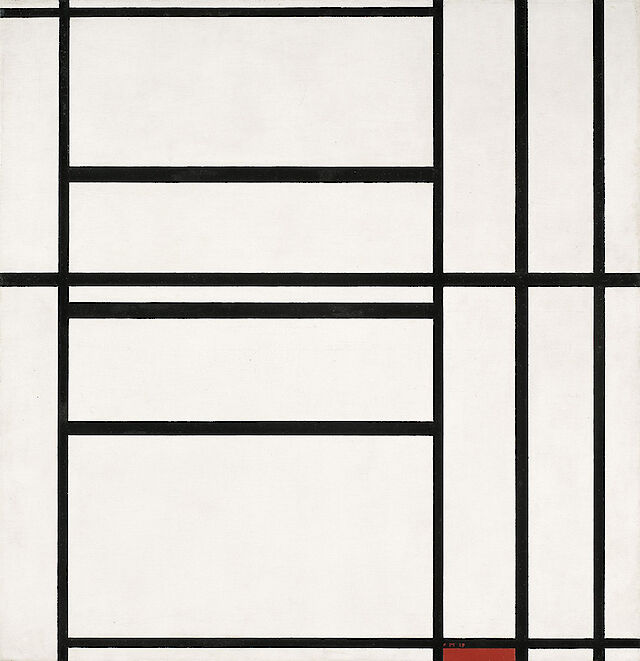
Piet Mondrian, Composition No. 1 with Grey and Red 1938 / Composition with Red 1939 is the subject of a conservation research project at the Peggy Guggenheim Collection.
Venice, March 15, 2021 - While Palazzo Venier dei Leoni is still closed to visitors, the Peggy Guggenheim Collection is pleased to announce that it will commence the study and conservation of Piet Mondrian’s Composition No. 1 with Grey and Red 1938 / Composition with Red 1939 (1938–39). The museum’s conservation department will launch the project in March 2021. Among the masterpieces most loved by the public, Mondrian’s work captures the viewer’s attention with its harmonic and rhythmic balance of pure forms and intersecting horizontal and vertical lines.
Following significant conservation projects on Jackson Pollock, Alchemy (1947); Pablo Picasso, The Studio (1928); and Marcel Duchamp, Box in a Valise (1941), this marks the investigation of another twentieth-century icon in the Peggy Guggenheim Collection. Researching the painting is fundamental for an in-depth understanding of the materials and techniques Mondrian used. Tracing the work’s conservation history is also key to informing and guiding its eventual treatment.
The painting has two titles that reflect reworkings by the artist. Scientific investigation will determine the placement of the grey color in the first version of the painting, Composition No. 1 with Grey and Red from 1938, which Mondrian removed, prompting the new title: Composition No. 1 with Grey and Red 1938 / Composition with Red 1939. In 1943, Max Bill—Mondrian’s architect and designer friend to whom the artist often sent pictures of his works in progress, including Composition with Red—wrote that the first version of the painting included a small grey box at the top left. During a conversation with Angelica Rudenstine, author of the Peggy Guggenheim Collection catalogue raisonné, Peggy Guggenheim (who acquired the work by November 1939), suggested that Mondrian modified the painting in New York before the opening of her museum/gallery Art of This Century, in 1942. Therefore, the change could have occurred between 1941 and 1942. However, in a 1939 reproduction in the London Bulletin, the painting seems to have already been altered, since the grey box is absent. It is possible that Mondrian intervened again on the work before the inauguration of Art of This Century, though less drastically than in 1939. Mondrian repeatedly returned to his paintings, perfecting the black of the lines and the subtle tones of the whites.
Composition No. 1 with Grey and Red 1938 / Composition with Red 1939 is one of the few paintings that the Dutch artist worked on during his two-year stay in London between 1938 and 1940, as the threat of World War II was growing. At the time, Mondrian was striving to abandon subjectivity in his art. The simplicity of the canvases he produced then could be interpreted as a response to the complications of that era. In this light, the painting assumes great historical importance as a manifesto of the objective aesthetics of Neo-Plasticism. Indeed, it is one of his most chromatically reductive compositions. Stern and austere, but also intuitive, the work offers an abstract schema for the uncertainty and the search for order during one of history’s most dire periods.
Peggy Guggenheim met Mondrian for the first time in London 1938, was taken with his art, and he became a main point of reference in her avant-garde circle. In her autobiography, Out of This Century (London: Andre Deutsch, 1979), Guggenheim recalls numerous anecdotes that characterized their unique friendship, such as Mondrian’s love, despite being seventy-years old, for dancing, listening to jazz, and attending social events and parties.
Luciano Pensabene Buemi, Conservator of the Peggy Guggenheim Collection, will coordinate this interdisciplinary study and treatment of the painting. He will oversee the collaboration with the ISPC, Istituto di Scienze del Patrimonio Culturale, and SCITEC Istituto di Scienze e Tecnologie Chimiche of the CNR, Consiglio Nazionale delle Ricerche, aimed at capitalizing on the most advanced technologies for non-invasive in-situ analyses. Scientific analyses will allow for the identification of materials and techniques Mondrian employed, and will enable essential monitoring of the painting during treatment. The study will involve the conservation and curatorial departments of the Peggy Guggenheim Collection and the Solomon R. Guggenheim Museum in New York. Lena Stringari, Deputy Director and Andrew W. Mellon Chief Conservator of the Solomon R. Guggenheim Foundation will oversee the project together with Gillian McMillan, Associate Chief Conservator for the Collection at the Solomon R. Guggenheim Museum in New York, bringing their previous experience with Mondrian’s works to the project. Comparative study of unrestored paintings and dialogue with Mondrian experts in the field, including curators, art historians, conservators, and scientists will be crucial to this project. This research and interdisciplinary dialogue will ensure an informed and sensitive treatment of Composition No. 1 with Grey and Red 1938 / Composition with Red 1939, a twentieth-century masterpiece.